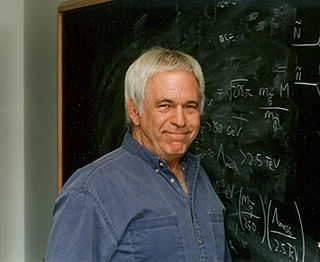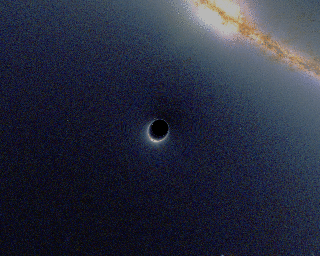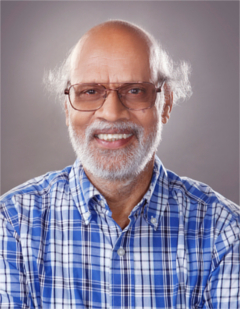In supergravity theories combining general relativity and supersymmetry, the gravitino is the gauge fermion supersymmetric partner of the hypothesized graviton. It has been suggested as a candidate for dark matter.
In theoretical physics, the Rarita–Schwinger equation is the relativistic field equation of spin-3/2 fermions in a four-dimensional flat spacetime. It is similar to the Dirac equation for spin-1/2 fermions. This equation was first introduced by William Rarita and Julian Schwinger in 1941.

Alexander Vilenkin is the Leonard Jane Holmes Bernstein Professor of Evolutionary Science and Director of the Institute of Cosmology at Tufts University. A theoretical physicist who has been working in the field of cosmology for 25 years, Vilenkin has written over 260 publications.
Pran Nath is a theoretical physicist working at Northeastern University, with research focus in elementary particle physics. He holds a Matthews Distinguished University Professor chair.

Pervez Amirali Hoodbhoy is a Pakistani nuclear physicist, author, media commentator, and social activist. He is generally considered one of the most vocal, progressive and liberal members of the Pakistani intelligentsia. Hoodbhoy is known for his opposition to nuclear weapons and vocal defence of secularism, freedom of speech, scientific temper and education in Pakistan. Some senior journalists, political and army figures have leveled accusations of treason and unbelief against him but he has rebutted them. Instead he regards himself as a global citizen. His physics-math course lectures, as well as on popular science topics, are widely watched and available online.
In quantum field theory, soft-collinear effective theory is a theoretical framework for doing calculations that involve interacting particles carrying widely different energies.

John (Jean) Iliopoulos is a Greek physicist. He is the first person to present the Standard Model of particle physics in a single report. He is best known for his prediction of the charm quark with Sheldon Glashow and Luciano Maiani. Iliopoulos is also known for demonstrating the cancellation of anomalies in the Standard model. He is further known for the Fayet-Iliopoulos D-term formula, which was introduced in 1974. He is currently an honorary member of Laboratory of theoretical physics of École Normale Supérieure, Paris.
Ni Wei-tou is a Taiwanese physicist, who graduated from the Department of Physics of National Taiwan University (NTU), and got his PhD of Physics & Mathematics from California Institute of Technology. After his retirement on 1 October 2000, he is now appointed as a professor emeritus of the Department of Physics of National Tsing Hua University (NTHU) at Hsinchu, Taiwan, since 2006.

Christopher T. Hill is an American theoretical physicist at the Fermi National Accelerator Laboratory who did undergraduate work in physics at M.I.T., and graduate work at Caltech. Hill's Ph.D. thesis, "Higgs Scalars and the Nonleptonic Weak Interactions" (1977) contains one of the first detailed discussions of the two-Higgs-doublet model and its impact upon weak interactions. His work mainly focuses on new physics that can be probed in laboratory experiments or cosmology.

Xiao-Gang Wen is a Chinese-American physicist. He is a Cecil and Ida Green Professor of Physics at the Massachusetts Institute of Technology and Distinguished Visiting Research Chair at the Perimeter Institute for Theoretical Physics. His expertise is in condensed matter theory in strongly correlated electronic systems. In Oct. 2016, he was awarded the Oliver E. Buckley Condensed Matter Prize.

Anthony Ichiro Sanda is a Japanese-American particle physicist. Along with Ikaros Bigi, he was awarded the 2004 Sakurai Prize for his work on CP violation and B meson decays.
In quantum field theory, a non-topological soliton (NTS) is a soliton field configuration possessing, contrary to a topological one, a conserved Noether charge and stable against transformation into usual particles of this field for the following reason. For fixed charge Q, the mass sum of Q free particles exceeds the energy (mass) of the NTS so that the latter is energetically favorable to exist.
Allan Blaer is a physicist, professor emeritus and special lecturer at Columbia University in New York City. He received his undergraduate degree from Columbia University in 1964, where he was the valedictorian. He later went on to obtain his PhD in physics at the same institution. He has done research in both theoretical and experimental physics. In quantum field theory, he worked on phase transitions in low-temperature bosonic and fermionic systems, quantum field theory anomalies, dyons and magnetic monopoles in non-abelian gauge theories, and renormalization theory. In experimental physics, he has worked on precision measurement of vacuum polarization in muonic atoms to test quantum electrodynamics.
Standard-Model Extension (SME) is an effective field theory that contains the Standard Model, general relativity, and all possible operators that break Lorentz symmetry. Violations of this fundamental symmetry can be studied within this general framework. CPT violation implies the breaking of Lorentz symmetry, and the SME includes operators that both break and preserve CPT symmetry.

Gordon Leon Kane is Victor Weisskopf Distinguished University Professor at the University of Michigan and director emeritus at the Leinweber Center for Theoretical Physics (LCTP), a leading center for the advancement of theoretical physics. He was director of the LCTP from 2005 to 2011 and Victor Weisskopf Collegiate Professor of Physics from 2002 - 2011. He received the Lilienfeld Prize from the American Physical Society in 2012, and the J. J. Sakurai Prize for Theoretical Particle Physics in 2017.

Relativistic images are images of gravitational lensing which result due to light deflections by angles .
In physical cosmology, warm inflation is one of two dynamical realizations of cosmological inflation. The other is the standard scenario, sometimes called cold inflation.
Searches for Lorentz violation involving photons provide one possible test of relativity. Examples range from modern versions of the classic Michelson–Morley experiment that utilize highly stable electromagnetic resonant cavities to searches for tiny deviations from c in the speed of light emitted by distant astrophysical sources. Due to the extreme distances involved, astrophysical studies have achieved sensitivities on the order of parts in 1038.

Daya Shankar Kulshreshtha is an Indian theoretical physicist, specializing in formal aspects of quantum field theory, string theory, supersymmetry, supergravity and superstring theory, Dirac's instant-form and light-front quantization of field theories and D-brane actions. His work on the models of gravity focuses on the studies of charged compact boson stars and boson shells.

Thomas Hertog is a Belgian cosmologist at KU Leuven university and was a key collaborator of Professor Stephen Hawking.










